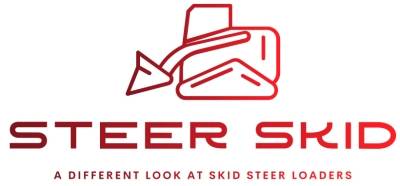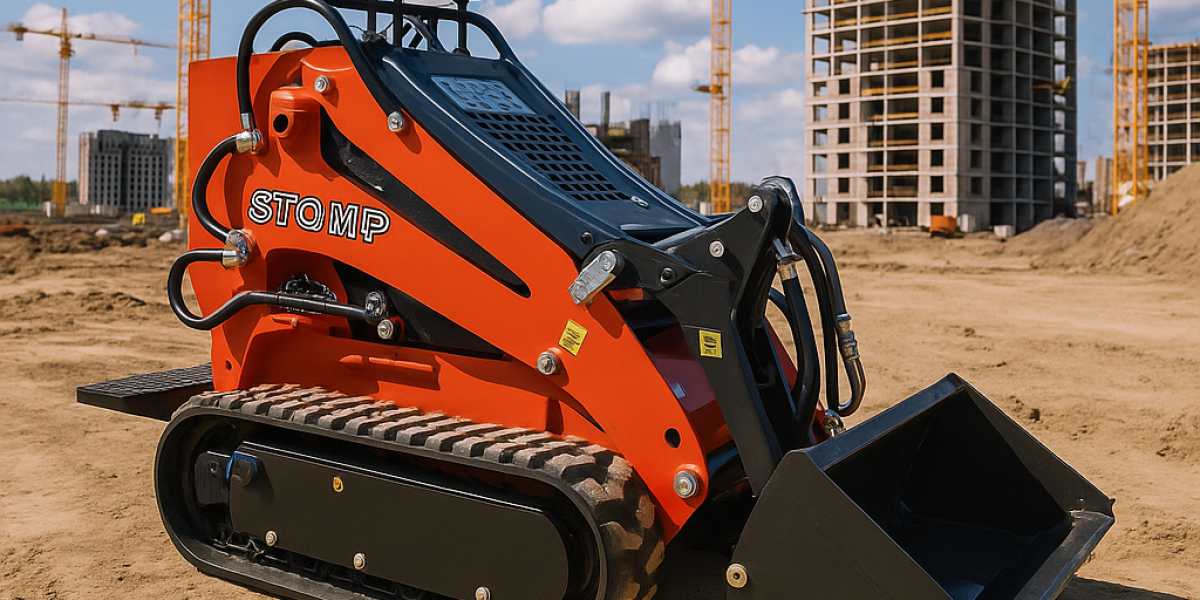Skid steer loaders are versatile industrial machines widely used in construction, landscaping, and agriculture. The skid steer is a compact vehicle with a very small turning radius, and its wheels operate at different speeds to facilitate maneuverability. It has a structure that no other machinery has, which makes it ideal for different tasks still.
Depending on the attachments prefitted on the other end of the loader’s lift arms, the machine can move, load, and even lift materials, making it extremely useful.
In summary, the skid steer can navigate through even the most challenging areas, making it essential for residential landscaping projects.
A skid steer is easily recognizable due to its unique steering mechanism. Skid steers are not typical vehicles that use the front axle to turn; they adopt a special technique – skid steering. This technique allows the vehicle to perform smooth turns at any point in a circle by having the two wheels on each side work separately.
This unique function of skid steer construction makes for easier mobility in addition to the opportunity for the operator to make U-turns and easily move through very narrow roads.
The hydraulic drive system of the loader significantly enhances its performance, enabling it to perform heavy-duty tasks such as lifting loads and operating specialized attachments such as buckets, forks, and augers. Having learned the pivotal details of the skid-steer loader is the primary requirement for using this machine efficiently.
Key Takeaways
- It is common to see skid-steer loaders in construction, landscaping, and agriculture, where they can be used for a myriad of different tasks.
- The use of safety precautions and recommended guidelines while operating a skid-steer loader is vital to preventing unsafe conditions and accidents.
- Skid-steer loaders require regular maintenance and thorough checkups to avoid underperformance and early failure.
- Mastering the basic skills of steering, lifting, and loading is the first step toward ensuring safety and efficiency in skid-steer loader operation.
- Advanced tasks such as grading, trenching, and material handling can accelerate the speed of a skid-steer loader significantly.
- The performance of a skid-steer loader, as well as the safety of the operator and the equipment, is highly influenced by possessing the knowledge to operate on different terrains and under varied weather conditions.
- Detection and fixing of issues like hydraulic system malfunctions and electrical malfunctions greatly add to the usefulness and lifetime of the skid-steer loader.
- Add to the above list that they will be well-informed about the latest trends and get regular training, and they will maintain their skills through education or training outlets, apart from daily practice, and be the master operators of the skid-steer loader that can ensure maximum productivity and safety.
Safety Precautions and Best Practices
Pre-Operation Checks
It is necessary for people to check the level of oil, inspect the tires for wear or damage, and see that all the safety devices, like seat belts and rollover protective structures (ROPS), work correctly.
Drivers should also learn the machine’s tools and functions, as well as the implements they will use. This knowledge makes them work more effectively and considerably reduces the likelihood of accidents.
Situational Awareness
In cases like these, workers must still be aware of the environment, especially in busier work areas with the presence of other people or equipment.
One really good way they are should have a clear set of communication signals with ground personnel to avoid blind spots and language barriers.
On the same note, the operator should also avoid the edges of excavations or slopes at all times in order to minimize the possibility of turning danger over.
Personal Protective Equipment
Proper Maintenance and Inspection
It is crucial to always take good care of our equipment and do inspections regularly to ensure that our skid-steer loader machines remain efficient and reliable. A machine that is in good condition gives better performance and lowers the chances of it breaking down unexpectedly, thus saving money on repairs.
Furthermore, the operators need to stick to a set schedule of maintenance that includes checking the engine oil levels, hydraulic fluids, and coolant in the machine.
First and foremost, cleaning the filters of dirt and debris is a must for the engine to function at its best. A clean machine is also less likely to corrode and will thus last longer. Besides having regular checks, the operators also need to pay attention to the tires’ condition and the tracks.
It is important that the tire pressure is good, as it requires good traction and stability during the work process. Worn-out tires tend to perform less effectively and consume more fuel. In addition, it is essential to inspect the hydraulic system regularly since oil leaks are safety hazards that can also affect the control of the attachment.
By combining daily inspections and regular servicing by qualified technicians into a comprehensive maintenance program, operators guarantee the untarnished performance of their skid-steer loaders.
Getting to the Cs of Operation and Their Types
When it comes to the effective operation of a skid-steer loader, first, one needs to have basic controls and functions of the machine mastered. The main controls are usually represented by two joysticks, which are responsible for the machine’s movement and the working tools’ operation. The left joystick usually controls movement and attachment, while the right one controls the lift arms and bucket tilt.
Knowing the way these controls operate among themselves is what makes for smooth operation. For example, moving both joysticks forward and lifting the bucket at the same time allows the machine to move ahead; conversely, pulling them makes the machine move while the bucket lowers.
Practicing these simple exercises in an open area can help new operators gain confidence, allowing them to operate easily when they move on to tackle the hardest jobs.
Basic tasks like going straight, turning quickly, and moving back and forth can make the operator more aware of the machine’s behavior. Moreover, the skill of using different lift truck attachments, such as the bucket for digging or the forks for lifting tasks, requires the same level of performance as practicing them to ensure precision and control.
As the operators get the hang of these primary functions, they should think about their new options for even better and faster work at the construction site.
Advanced Techniques for Efficient Operation
At the point when workers have the basic skills of operation under control, they can proceed to discover advanced techniques that will help them make work more productive.
A good example is load management—knowing the art of balancing the loads one is handling can save one from any unnecessary injuries and, in addition, enhance the stability during the operation. Take, for instance, in the case of lifting a heavy material; it is a must to have the load at the bottom to keep the center of gravity low.
This not only assures safety but also has the additional benefit of better visibility during a route passing through narrow spaces. Among other things, using the equipment’s hydraulics at the highest level is an example of a highly demanding technique. Specifically, users learn how to use multiple implements in parallel to perform more difficult tasks.
One of the prime examples is powering a loading bucket to simultaneously scoop up some material while the grapple attachment is in place to grip and hold larger objects tightly.
Moreover, getting the hang of processes like backfilling or grading is only possible through having a perfect understanding of the bucket angle and the proper positioning of the attachment.
By mastering these advanced skills, operators can optimize their resources and reduce the wear and tear on equipment and setups.
Handling Different Terrains and Conditions
Operating on Soft or Muddy Ground
When the ground is soft or muddy, the distribution of weight and increased traction are necessary for safe operation. In these situations, the use of wider tires or tracks compatible with good flotation helps in case one wants to prevent the machine from sinking in the ground. The operator must also be cautious of sudden movements that could tip or sink the machine.
Operating on Hard Surfaces
When the rough surface is the one in question, the worker has to be aware of the fact that his tires can wear and also damage the surface where he is working.
The adjustment of speed and the use of attachments that are suitable in the situation will help decrease the wear both the machine and the work surface evenly.
Operating on Slopes or Uneven Terrain
When driving on slopes or uneven terrain, it is necessary to maintain a low center of gravity in the vehicle by placing the loads near the ground so that complete prevention of overturning is achieved.
Knowing how different terrains influence the machine’s performance gives the operators the ability to change their methods, working in a safe and efficient manner, no matter what kind of conditions there are.
Troubleshooting Common Issues
Even when skid-steer loaders are well-maintained, they might still experience common issues for which operators are required to have troubleshooting skills.
A common issue is the failure of the hydraulic system, which can be identified by the slow or non-reactive movement of the attachments. The first step is to check if the hydraulic fluid level is low and to inspect for any hose leakage or damage.
If there is enough fluid but still the problems persist, it may be understood that proper diagnosis and changing of the hydraulic parts are required.
Then there is another typical problem, which is engine performance issues that can include for example difficult ignition and stopping of the engine during its operation. The first thing an operator should do is check the fuel level and ensure that the filters are both clean and free from blockages.
If these initial checks don’t do the trick, you can try to find a good manual for the machine to help you solve this problem, or call a qualified technician for his experienced opinion.
The development of troubleshooting skills among operators not only enables them to fix simple issues on their own but also encourages a more profound understanding of the mechanics of their equipment.
Continuing Education and Training Opportunities
With the rapid advancement in technology within the construction industry, continuous education and training are a must for skid-steer operators who want to stay abreast of current and upcoming best practices and developments in machinery.
Many manufacturers organize training programs that cover basic operation and advanced techniques specific to their models and go as far as offering to train the trainees.
These programs typically include hands-on training sessions led by experienced instructors who impart valuable knowledge to the trainees.
Moreover, safety protocols, maintenance practices, and technologically advanced skid-steer loader workshops and seminars are frequent in the industry.
There is no doubt that participating in these events helps improve the skill set and offers networking opportunities with other professionals in the field.
Additionally, online courses are gaining popularity as they offer individuals great flexibility and convenience and provide an opportunity for busy skid-steer operators to improve their skills—all at their pace.
Continuing education and training opportunities are essential investments that people make in their skills to ensure they stay very proficient in their field even as the industry continues to evolve.

